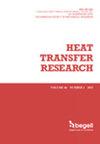HORIZONTAL SINUSOIDAL WAVY FORM PLATE-FIN HEAT SINKS FOR NATURAL CONVECTION HEAT DISSIPATION
IF 1.6
4区 工程技术
Q3 THERMODYNAMICS
引用次数: 0
Abstract
The plate-fin heat sink geometry was modified to have the fin form sinusoidal wave shape in the horizontal direction with twelve variations by amplitude and period changes. Three different wave periods and four different wave amplitudes were used. The purpose was to alter natural convection motion in favor of heat transfer effectiveness. The main performance indicator was the base-plate average temperature. The independent geometric parameters were experimentally examined in terms of the effectiveness of natural convection heat transfer by the measured average temperature values. Heat transfer by radiation was calculated by an analytical algebraic approach in order to obtain the Nusselt number solely based on convective heat transfer. Eight different heat inputs were used for each tested geometry to change the Grashof and Rayleigh numbers in a laminar flow interval. As reference geometries, a flat plate and a heat sink with straight/flat-plate fins were utilized. The heat sinks were also oriented to three different angles by a test stand. Accordingly, thirty six unique experimental cases were examined as a result of 327 trials and 1100 hours of testing. It was realized that the wavy fin geometry enhances natural convection heat transfer compared to the base-plate and flat-plate-fin heat sinks. However, increasing period and amplitude of the wave form more than initial values deteriorated the gains by the modifications on the fins. Since a single-period, 2-mm-amplitude heat sink resulted in the highest Nusselt number for all orientations, an optimum may be sought about this setting. As a general evaluation, computational simulations for spatial resolution of the event physics and dimensional optimization are standing as future study targets.用于自然对流散热的水平正弦波浪形板翅式散热器
对板翅式散热器的几何形状进行了修改,使翅片在水平方向上形成正弦波形,并通过振幅和周期变化产生十二种变化。使用了三种不同的波周期和四种不同的波幅。目的是改变自然对流运动,以提高传热效果。主要性能指标是底板平均温度。通过测量平均温度值,实验检验了独立几何参数对自然对流传热效果的影响。通过分析代数方法计算了辐射传热,以获得仅基于对流传热的努塞尔特数。对每个测试几何体使用了八种不同的热输入,以改变层流区间的格拉肖夫数和瑞利数。作为参考几何形状,使用了平板和带有直/平板鳍片的散热器。散热器还通过试验台进行了三个不同角度的定向。因此,经过 327 次试验和 1100 个小时的测试,对 36 个独特的实验案例进行了检验。结果表明,与底板和平板-鳍片散热器相比,波浪形鳍片几何形状增强了自然对流传热。然而,波形的周期和振幅比初始值增加,会使鳍片上的改性增益效果变差。由于单周期、2 毫米振幅的散热片在所有方向上都能获得最高的努塞尔特数,因此可以对这一设置进行优化。作为总体评估,未来的研究目标是对事件物理的空间分辨率和尺寸优化进行计算模拟。
本文章由计算机程序翻译,如有差异,请以英文原文为准。
求助全文
约1分钟内获得全文
求助全文
来源期刊

Heat Transfer Research
工程技术-热力学
CiteScore
3.10
自引率
23.50%
发文量
102
审稿时长
13.2 months
期刊介绍:
Heat Transfer Research (ISSN1064-2285) presents archived theoretical, applied, and experimental papers selected globally. Selected papers from technical conference proceedings and academic laboratory reports are also published. Papers are selected and reviewed by a group of expert associate editors, guided by a distinguished advisory board, and represent the best of current work in the field. Heat Transfer Research is published under an exclusive license to Begell House, Inc., in full compliance with the International Copyright Convention. Subjects covered in Heat Transfer Research encompass the entire field of heat transfer and relevant areas of fluid dynamics, including conduction, convection and radiation, phase change phenomena including boiling and solidification, heat exchanger design and testing, heat transfer in nuclear reactors, mass transfer, geothermal heat recovery, multi-scale heat transfer, heat and mass transfer in alternative energy systems, and thermophysical properties of materials.
 求助内容:
求助内容: 应助结果提醒方式:
应助结果提醒方式:


